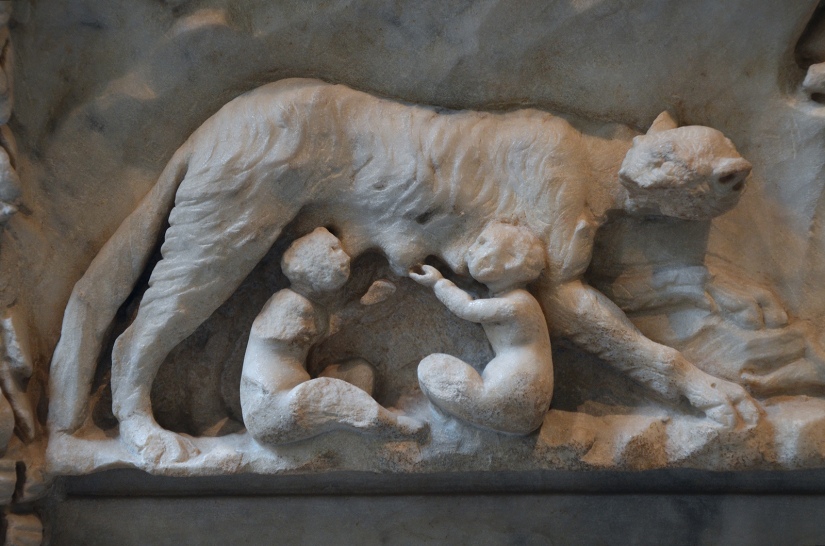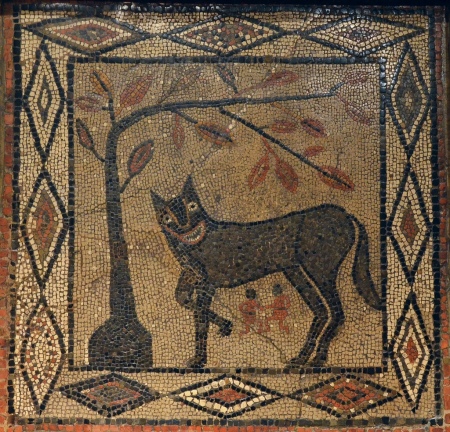 The she-wolf feeding the twins Romulus and Remus, the most famous image associated with the founding of Rome.
The she-wolf feeding the twins Romulus and Remus, the most famous image associated with the founding of Rome.Today (21st April) is the traditional date given for the founding of Rome. According to Roman mythology, the founders were Romulus and Remus, twin brothers and supposed sons of the god Mars and the priestess Rhea Silvia. The twins were then abandoned by their parents as babies (because of a prophecy that they would overthrow their great-uncle Amulius), but were saved by a she-wolf who nursed them. Romulus killed his brother after a vicious quarrel and went on to establish a city which he named after himself.
Although the original date given by Roman historians for the founding of Rome varied between 758 and 728 BC, the official date was set as 753 BC. Archaeologists have traced evidences of villages on the Palatine Hill dating back to around the 9th century BC.
The ancient Romans celebrated the founding of their city every April 21st in the festival of Parilia. This festival was originally aimed at cleansing both sheep and shepherds in honour of Pales, the goddess of shepherds, but was later associated with the founding or Rome. The connection between these two characters of the festival is evident as the founders of the city, Romulus and Remus, grew up to be shepherds like their adoptive father.

Representation of the lupercal: Romulus and Remus fed by a she-wolf, surrounded by representations of the Tiber and the Palatine.
This panel comes from a sacrificial altar dedicated to the divine couple of Mars and Venus found at Ostia (Italy). This side of the altar shows a scene with the she-wolf nursing Romulus and Remus, a personification of the river Tiber, and two fleeing shepherds, probably Faustulus, adoptive father of the twins and his brother Faustinus. On the left is the personification of the Palatine, also dressed as a shepherd. The eagle of Jupiter, symbolically hovering over the sacred grotto of the Lupercal, indicates that the events are unfolding under divine auspices.

Representation of the lupercal: Romulus and Remus fed by a she-wolf, surrounded by representations of the Tiber and the Palatine.
The altar carries various inscriptions. One of the inscription tells us that the altar was later used as a pedestal for a bronze statue of the god Silvanus. The consuls mentioned in the text inscribed securely date the inscription to October 1st, 124 AD. In this period Hadrian promoted renewed interest in themes related to the origins of Rome.
 https://followinghadrian.files.wordpress.com/2018/02/an00253480_001_l_burned.jpg?w=150 150w, https://followinghadrian.files.wordpress.com/2018/02/an00253480_001... 300w" sizes="(max-width: 711px) 100vw, 711px" />
https://followinghadrian.files.wordpress.com/2018/02/an00253480_001_l_burned.jpg?w=150 150w, https://followinghadrian.files.wordpress.com/2018/02/an00253480_001... 300w" sizes="(max-width: 711px) 100vw, 711px" />Gold coin of Hadrian struck to commemorate games held on April 21, 121 AD to mark the 874th birthday of the city of Rome. © The Trustees of the British Museum
This aureus of Hadrian was struck in 121 AD to commemorate the circus games that marked the 874th birthday of the city of Rome. The reverse of the coin depicts the Genius of the Circus Maximus with the legend “ANN. DCCCLXXIIII NAT. VRB. P. CIR. CON.” meaning that in the 874th year, circus games were for the first time instituted (Circenses constituta) for the natalis urbis romae(birthday of the city).
In the same year, while celebrating the Parilia festival, Hadrian founded a new temple dedicated to Venus, the divine ancestress of the Roman people, and to Roma herself. The temple was to stand on the north side of the Sacred Way on a great podium, stretching from just beyond the Arch of Titus and almost as far as the Colosseum. The two goddesses would be placed back to back with one cella facing toward the Colosseum, the other facing towards the Forum. As Dio Cassius tells us, Hadrian himself seems to have personally designed the temple. However, construction of the temple did not begin until 125 AD.

Temple of Venus and Roma, Upper Via Sacra, Rome
Having dedicated the temple, Hadrian changed the name of the Parilia festival to Romaia (the Natalis Urbis Romae) and associated the new Temple to the celebrations of the birthday of Rome. In addition Hadrian retraced the sacred boundary of the pomerium, the original line ploughed by Romulus around the walls of the original city. In doing so, Hadrian renewed the festival of Parilia in associating himself with Romulus.
One other coin minted in Rome in the year 121 proclaimed a new Golden Age (saeculum aureum).

HADRIAN, Gold Aureus “Saeculum Aureum” Rome Mint, 121 AD.
(courtesy of Stack’s Bowers)
This gold aureus featured on the reverse the Genius of the golden age “Saeculum Aureum” holding the zodiac and the phoenix on a globe, suggesting rebirth and renewal. Through this type of coin, Hadrian aimed at bringing the empire to its pinnacle while emphasising the power of Rome within the vast empire.

Mosaic depicting the She-wolf with Romulus and Remus, from Aldborough, about 300-400 AD, Leeds City Museum
Links and further reading:
- Founding of Rome – UNRV History
- Romulus and Remus, Ancient History Encyclopedia
- BBC Radio 4 – In Our Time, Romulus and Remus
- Sacello dell’Ara dei Gemelli (II,VII,3), Ostia-antica.org
Sources:
- Boatwright, M.T. (1987) Hadrian and the City of Rome, Princeton, NJ, Princeton University Press, pp. 121-122
- Birley, Anthony R. (1997) Hadrian: The Restless Emperor, London and New York: Routledge, pp. 112
- Marie-Henriette Quet (2004). L’aureus au zodiaque d’Hadrien, première image de l’éternité cyclique dans l’idéologie et l’imaginaire temporel romains – Revue numismatique Volume 6 Numéro 160 pp. 119-154 (link)













Pentru a putea adăuga comentarii trebuie să fii membru al altmarius !
Alătură-te reţelei altmarius